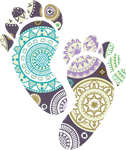Foot reflexology has been a welcomed complementary therapy for many people since the 1930s as the feet are easily accessible. The history of reflexology as an art of stress reduction based on the theory that the body is reflected on the feet in the shape of the body is the work of two American physicians, Dr. William FitzGerald and Dr. Joe Shelby Riley in the 1920s.

Dr. William FitzGerald (1872-1942) is credited with being the father of ‘zone therapy’. FitzGerald never published where he became acquainted with the theory of zone therapy nor does he give any credit to original sources preceding his. FitzGerald does not refer to any Oriental influence either. It is known he worked in Vienna beginning around 1899. It is here he may have learned of the use of pressure in medical practice. Upon his return to the United States several years later he discovered that if pressure were applied to the nose, throat and tongue, sensations in particular areas were deadened. This theory could also be applied to other boney areas including the feet and hands and other joints to provide pain relief. Zone therapy divides the body into ten zones—five on each side of the sagittal plane. The hands/arms and feet/legs were also divided into five zones each. Dr. Edwin Bowers in his book co-authored with Dr. FitzGerald, Zone Therapy in 1917 writes that FitzGerald discovered zone therapy in 1909 but gives no indication where he became acquainted with the theory. From 1915 into the early thirties the subject of zone therapy was controversial, but did meet with a certain amount of success with doctors and dentists as a form of pain relief or analgesia.
Dr. Joe Shelby Riley (1856 -1947), trained by Dr. FitzGerald further developed zone therapy by adding eight horizontal divisions to the zones of the feet and hands. His work is accurately the beginning of reflexology as it is known today—that is, reflexes found on the feet and hands that follow the anatomy of the body.
Riley’s work with reflexes and zones also included the hands and ears. Fitzgerald’s work had produced non-electrical applicators to aid in applying pressure. Riley added both electrical tools and developed a manual hooking technique with which to apply pressure.
During the 1930s Eunice D. Ingham (1889-1972) who met Riley as early as 1919 worked for Dr. Riley in St. Petersburg, Florida and continued to refine and improve his work. Eunice’s major contribution to working with reflexes was that alternating pressure, rather than having a numbing effect, stimulated healing. For forty years she lectured and traveled back and forth across the United States. She wrote three books in the process, often using the term ‘compression reflex massage’ though she never envisioned reflexology as part of massage. She saw reflexology as a separate discipline but felt if she used the medical term ‘reflexology’ she could get in trouble with the medical community. Eunice Ingham (Stopfel) limited her book reviews as she called her seminars to cities and towns in the USA and southern Canada. In the 1970s Eunice retired and the lecturing was taken over by her nephew, Dwight Byers who had been touring with her since 1948.
Prior to this it has been claimed reflexology started in such places as Egypt, Tibet, China or Native American Indians. There is no actual proof of this. However, the art and sculptures of indigenous cultures do indicate working on the feet.
Get In Touch

If you have any questions, please feel free to give me a call or send me an email.
